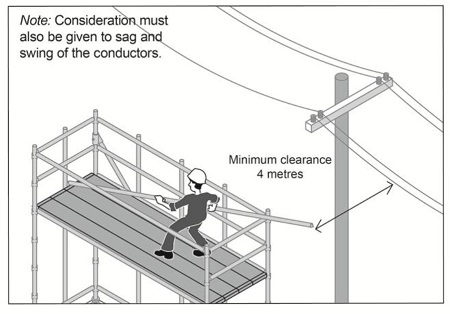This alert reminds workers of the hazards associated with handling conductive materials, such as scaffolding, steel reinforcing bars and edge-protection components, near overhead powerlines. Contacting or coming close to overhead powerlines could result in an electric shock, severe burns or even death.
Background
We responded to two incidents that involved workers handling conductive material near overhead powerlines.
In one incident, a worker was using a long metallic tube as part of a temporary edge-protection system and it hit overhead powerlines. The worker died and a colleague suffered serious burns.
In the second incident, a worker suffered permanent injuries when a steel reinforcing bar he was using hit overhead powerlines.
Risks
Contacting overhead powerlines is one of the most prevalent causes of death when using mobile plant and equipment. The same risks apply when handling conductive materials near overhead powerlines.
Any voltage that causes current to pass through the heart could be fatal. Serious burns can also occur. Fires and explosions are also possible.
You don’t need direct contact with overhead powerlines to get a fatal electric shock. Simply being too close can be fatal.
Action required
Check clearance and voltage
Before you start work near overhead powerlines, identify the height, clearance and voltage of the powerlines, to determine safe work zones and approach distances.
If you can’t determine the height, clearance and voltage, contact the electricity network operator, commonly referred to as an ENO.
Approach distance
The approach distance is the minimum distance you must maintain from overhead powerlines. The appropriate distance will avoid electrical flashovers, allow for sag and sway of the powerlines, and any movement of people, plant and materials.
The approach distances and work zones vary according to the voltage of the powerlines and the work being done. Do a risk assessment of the proposed work.
The Work near overhead power lines code of practice must be read together with the relevant Australian standard, such as the AS/NZS 4576:1995: Guidelines for scaffolding, which specifies a minimum four-metre approach distance for any metallic scaffolding used near overhead powerlines with a voltage up to and including 33 kV a.c.

Consult the electricity network operator
You must contact the relevant ENO – or complete and send their safety advice request form – if:
- you can’t determine the appropriate approach distance or work zone from the code and relevant Australian Standards
- you need to work within, or conductive materials might enter, the required approach distance.
They’ll send you a safety advice response (form 32) detailing the voltage and control measures. The response will outline potential costs if an outage is required, or Tiger Tails are needed.
Implement control measures
Make sure you follow the required approach distances and control measures when handling conductive materials from a temporary or fixed structure.
Follow the operator’s instructions outlined in the safety advice response (form 32) and let your workers know about the risks and controls. Keep the safety advice response onsite.
Even when working outside the four-metre (or greater) approach distance, check if there’s a risk of conductive material entering the safe approach distance. For example, when long scaffolding components are used, increase the approach distance or erect a physical barrier to prevent the material entering the specified approach distance.
More information
- Our Work near overhead power lines code of practice
- Safe Work Australia's Scaffolds and scaffolding work general guide
- Safe Work Australia’s Scaffolding work near overhead electric lines
- AS/NZS 4576:1995: Guidelines for scaffolding
Electricity network operators
- Ausgrid 13 13 65
- Endeavour Energy13 37 18
- Essential Energy 13 23 91
- Transgrid1800 222 537
- Sydney Trains131 500